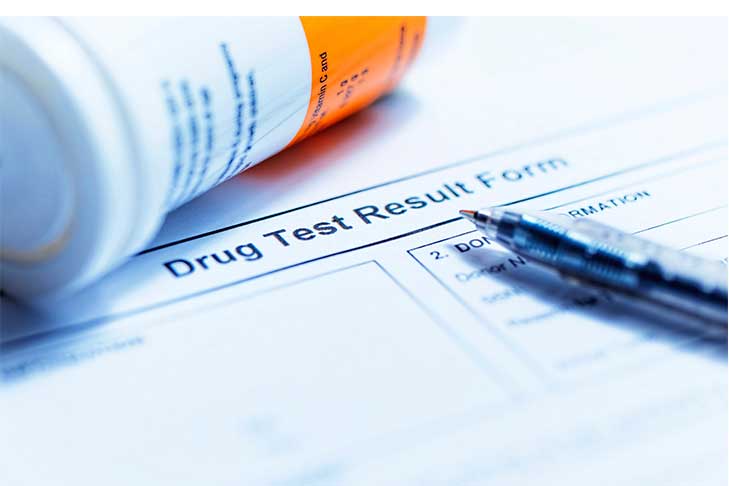How Long Does Oxycodone Stay In Your System?

Medically Reviewed By: Kimberly Langdon, M.D.

On average, oxycodone stays in your system and can be detected on drug tests for 2 to 4 days after the last use.
Oxycodone is a prescription opioid drug used for moderate to severe pain. It’s available in several formulations and brand names:
- oxycodone (Roxicodone, Xtampza ER)
- oxycodone and acetaminophen (OxyContin, Percocet, Roxicet)
- oxycodone and aspirin (Percodan)
If you have a drug test coming up or want to be sure you’ve completed an oxycodone detox, here are some guidelines on how long oxycodone stays in your system.
Oxycodone Half-Life
A drug’s half-life is how long it takes for your body to get rid of half of the drug concentration. The half-life of oxycodone is 4.5 to 6.5 hours.
This time frame depends on the type of drug you’re taking. Immediate-release formulations of oxycodone have an average half-life of 3.2 hours, while extended-release OxyContin has a half-life of 4.5 hours.
The effects of immediate-release oxycodone last about 4 to 6 hours. Extended-release oxycodone can be effective for up to 12 hours. The longer a drug is intended to work, the longer it will stay in a person’s system.
How Long Does Oxycodone Stay In Your System?
Oxycodone stays in your system for an average of 2 to 4 days. The presence of metabolites (what the drug breaks down into), such as noroxycodone, can also determine oxycodone use.
The amount of time oxycododne can be detected depends on the type of drug testing used:
- Urine tests can detect oxycodone and its metabolites for 2 to 4 days. The drug shows up in urine a couple of hours after your last use.
- Blood tests can detect oxycodone for about 24 hours. The drug is detectable in blood about 15 to 30 minutes after you use it.
- Saliva tests tend to be effective for 2 days or less. Oxycodone appears in saliva about 15 minutes after you take it.
- Hair tests have the longest detection window, with an average detection time of 90 days. Depending on where the hair follicle is tested (root or end), oxycodone may be detected for several months. It takes about a week after the last dose to show up on a hair test.
Factors That Affect Oxycodone Detection Times
Many factors can affect oxycodone detection times. How long oxycodone can be found in your system depends on your body and how you use the drug.
Kidney Function
Oxycodone is metabolized (broken down) in the kidneys. If your kidneys are impaired or diseased, it will be harder for them to break down drugs, so oxycodone may be detectable in your body longer. Someone with healthy kidneys can more easily and quickly metabolize oxycodone.
Age & Health
Older people tend to metabolize drugs more slowly as older bodies don’t always function as optimally as younger bodies. But health plays a factor as well.
An older person who takes great care of themselves—exercising, eating right, and staying hydrated—may metabolize oxycodone more quickly than a young person who eats junk food and sits around all day.
Metabolism
The speed of your metabolism can be affected by your age and health. But some people simply have faster metabolisms than others. A fast or slow metabolism may be genetic.
Body Mass
People with a high body mass index (BMI—height to weight ratio) tend to have slower metabolisms, while people with low body mass have faster metabolisms.
This rule can be affected by your physical health. Sometimes a high BMI results from working out all the time, which can speed up your metabolism. A low BMI may come from not eating, which is bad for your bodily functions.
Dosage, Frequency, & Time
If you take oxycodone as prescribed, your body should be able to break it down and excrete it within the average drug detection times. If you abuse oxycodone—taking high, overlapping doses—it will be harder for your body to process and may be in your system longer.
The length of time you’ve been taking oxycodone is a factor, too. If you’ve only taken oxycodone once, your body should process it quickly. If you’ve been taking it for years, it will probably stay in your system for longer after your last dose.
Mode Of Ingestion
Oxycodone comes as a capsule or tablet to be swallowed orally. People who abuse the drug may crush the pills and snort them, dissolve them in water for injection, or heat the tablet on foil and inhale the vapors.
Snorting (insufflation), smoking, and drug injection take oxycodone quickly into the bloodstream rather than allowing it to pass through the digestive system first. The result is an immediate and intense high and elevated blood concentration.
How you take oxycodone can determine how quickly it leaves your system. The body takes longer to process a drug through the digestive system before delivering it into the bloodstream. Swallowing oxycodone will keep it in your system the longest.
Cutoff Levels
The cutoff level of a drug test is the level at which there isn’t enough of the drug present to be significant. If there is no drug in your system or it’s below the cutoff level, you’ll get a negative result.
Drug tests can have different cutoff levels. A urine test may look for 50 nanograms per milliliter (ng/mL) of oxycodone and its metabolites. A saliva test might cut off at 1 ng/mL and a blood test at 5 ng/mL.
Other Drugs
If you take oxycodone with other drugs, it will likely stay in your system longer. Your body will have to work harder to process multiple substances and won’t be able to metabolize each one as quickly.
Oxycodone Addiction
Oxycodone provides pain relief by binding to opioid receptors and changing the way your brain perceives pain. It slows down your central nervous system to relax your body and mind.
While oxycodone can be helpful for people who’ve undergone surgery or have a sports injury, it usually isn’t intended for long-term use. It may be prescribed for chronic pain, but only for people who haven’t had success with other pain relief methods.
Oxycodone is a Schedule II controlled substance because of its high potential for drug abuse, addiction, and physical dependence.
Many people abuse oxycodone because of the calming sensation and euphoria they get from it. What begins as occasional relief can quickly turn into life-altering addiction.
If you’re concerned that a loved one is abusing oxycodone, don’t hesitate to reach out to us. At Ohio Recovery Center, we provide personalized opioid addiction treatment programs that nurture your spiritual, physical, and mental health.
We’re always available for a free and confidential consultation. Contact one of our treatment specialists today.
- Journal of Analytical Toxicology — The Disposition of Oxycodone and Metabolite in Human Hair https://academic.oup.com/jat/article/39/9/746/2363717
- Journal of Clinical Pharmacology — Pharmacokinetics of intranasal Crushed OxyContin and Intravenous Oxycodone in Nondependent Prescription Opioid Abusers https://www.ncbi.nlm.nih.gov/pmc/articles/PMC4006196/
- Learn.Genetics — Drug Delivery Methods https://learn.genetics.utah.edu/content/addiction/delivery/
- Mayo Clinic — Urine Drug Screening: Practical Guide for Clinicians http://drug-test.com.au/pdfs/10-Mayo-Clinic-Clinicians.pdf
- Substance Abuse and Mental Health Services Administration — Oxycodone and Hydrocodone: Detection in Urine, Oral Fluid, and Blood https://www.samhsa.gov/sites/default/files/meeting/documents/flegel-research-studies-dtab-june-2014.pdf

